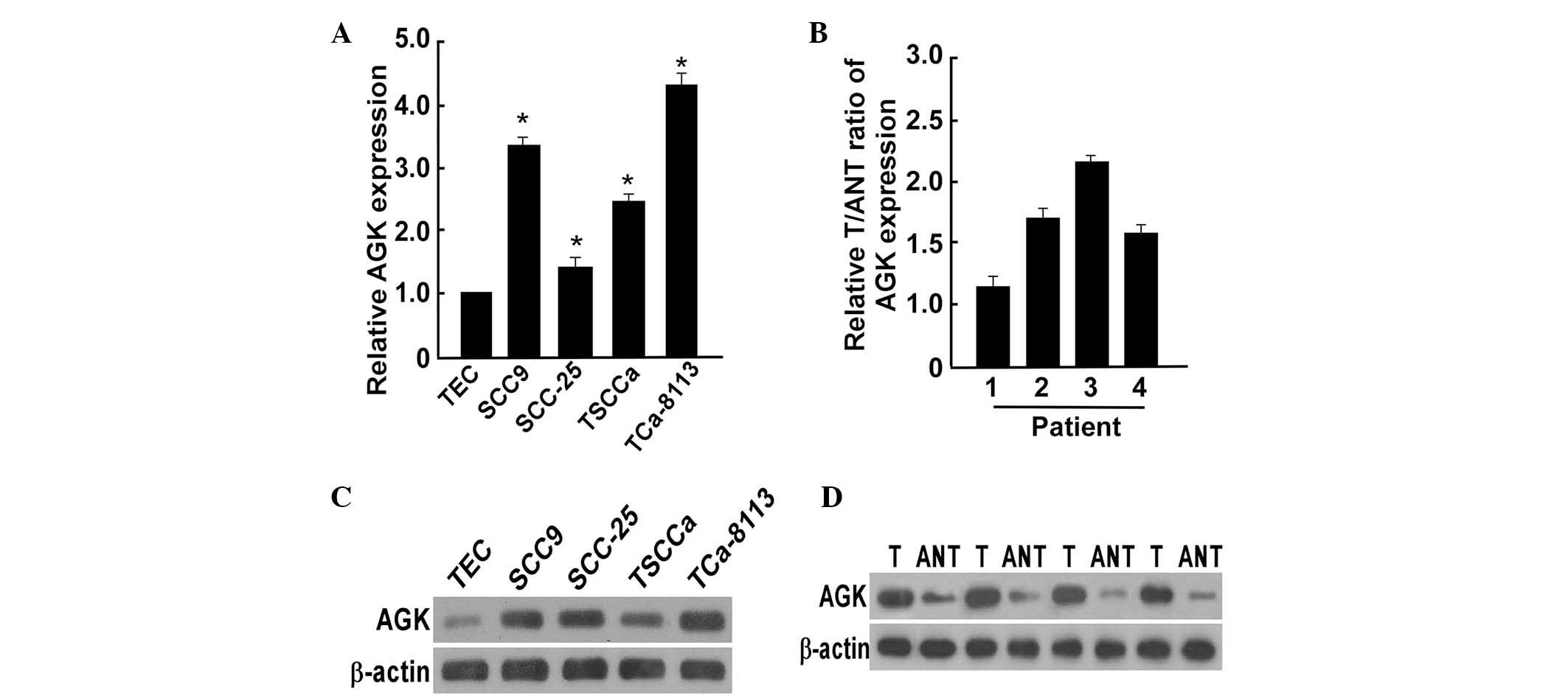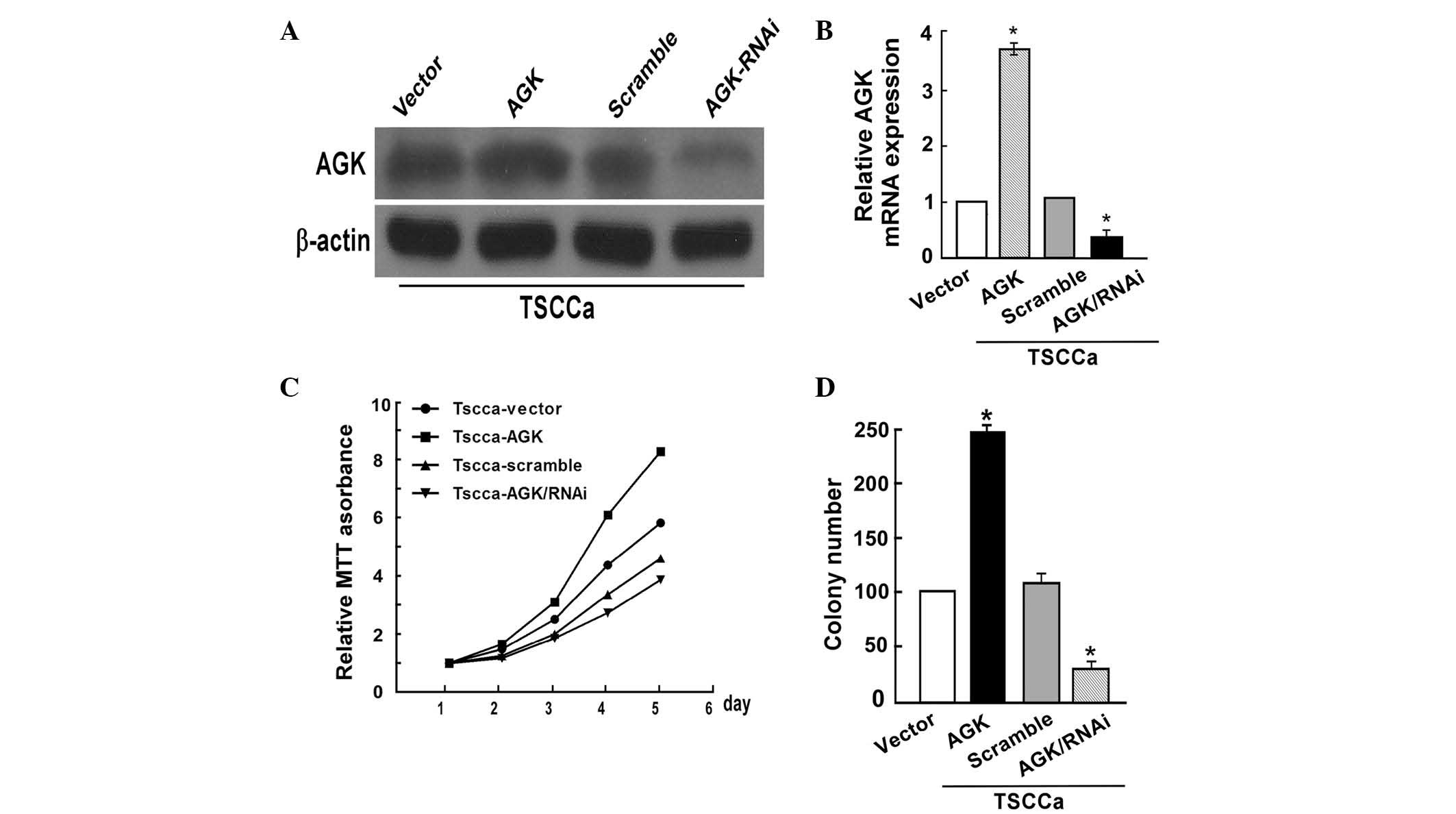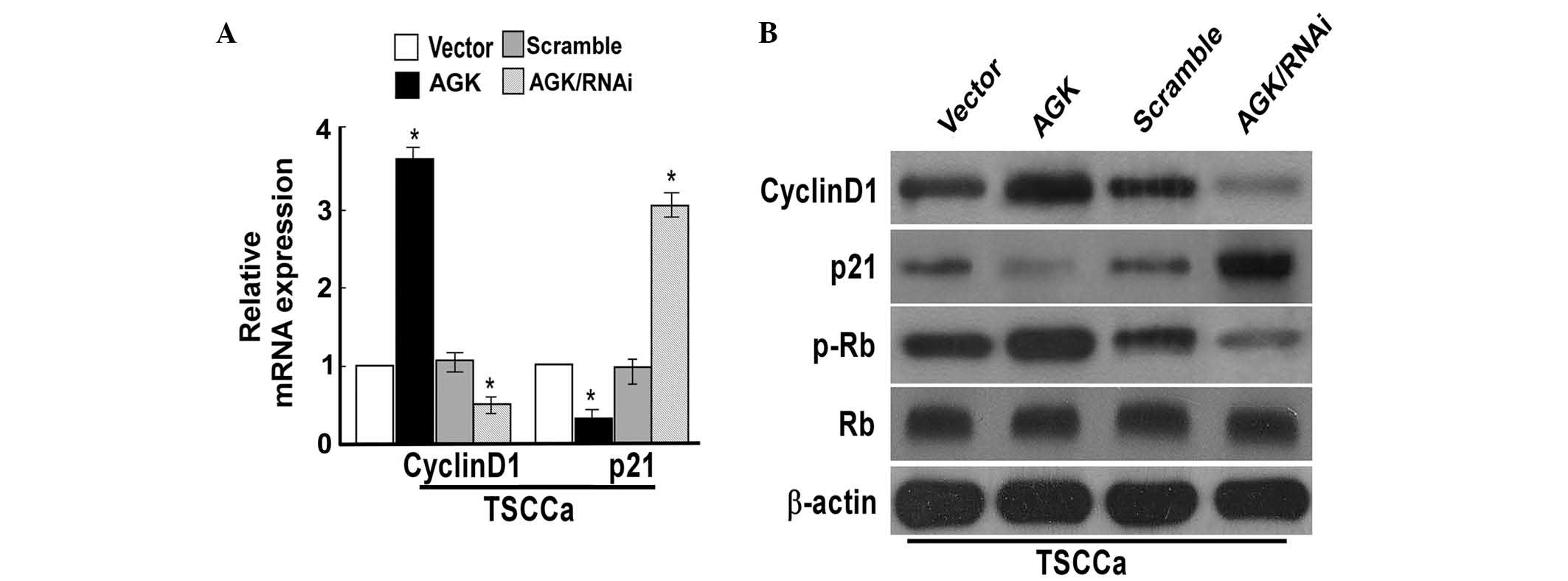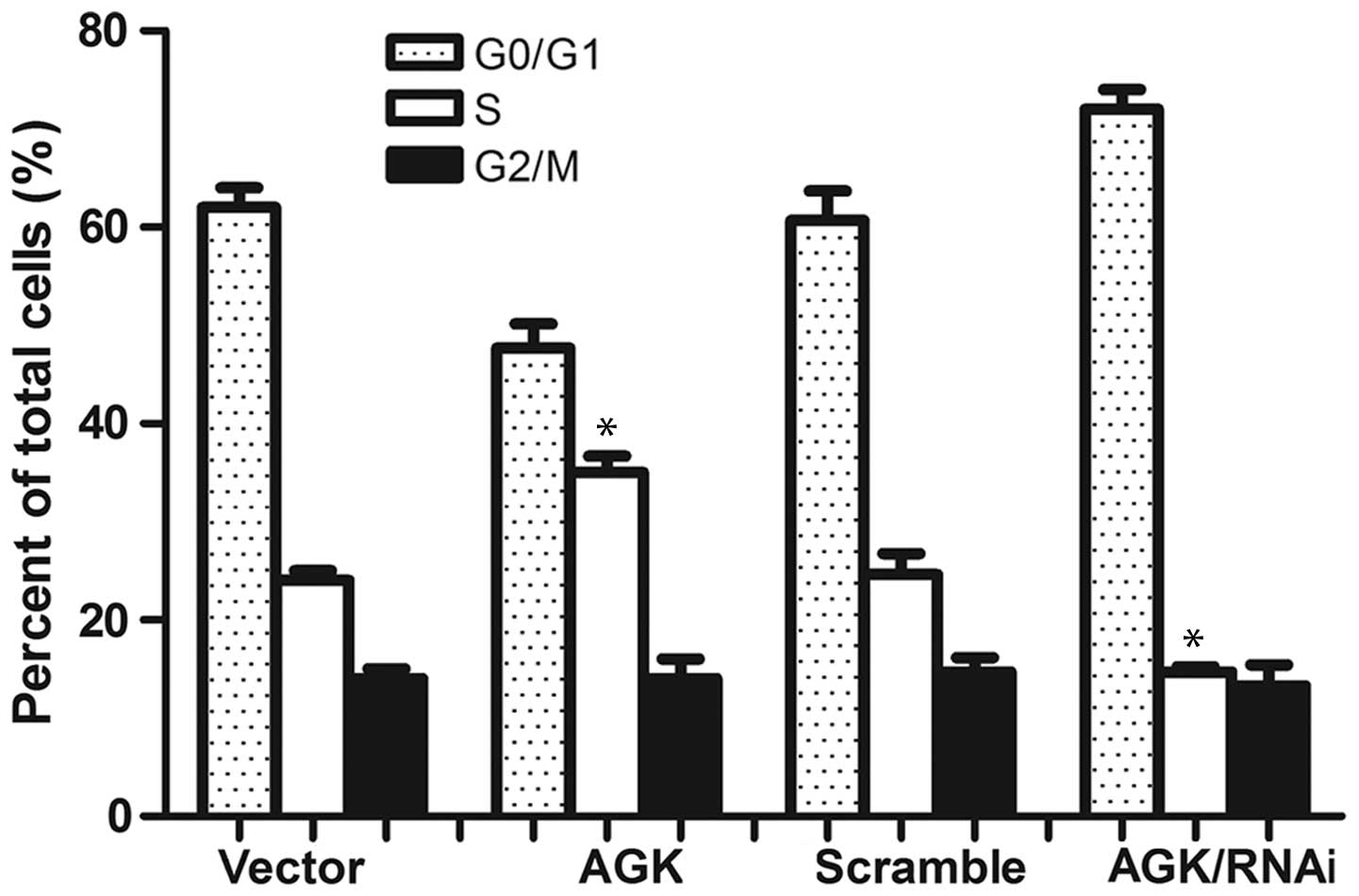Acylglycerol kinase promotes the proliferation and cell cycle progression of oral squamous cell carcinoma
- Authors:
- Published online on: April 8, 2015 https://doi.org/10.3892/mmr.2015.3602
- Pages: 2225-2230
Abstract
Introduction
Oral squamous cell carcinoma (OSCC) is the most common oral and maxillofacial malignancy, which is associated with high levels of incidence and mortality (1). Recently, the survival of patients with OSCC has improved, due to improvements in diagnostic and therapeutic strategies (2); however, OSCC remains a serious global health issue and therefore requires further study.
Acylglycerol kinase (AGK) is a multisubstrate lipid kinase (3). Overexpression of AGK has previously been shown to promote the proliferation of prostate cancer cells, suggesting that AGK may act as a potent oncogene (4,5). However, the underlying mechanisms of the effects of AGK on cell proliferation and cell cycle progression of OSCC remain to be elucidated. The cell cycle is a highly evolutionarily conserved mechanism. which facilitates the growth and proliferation of cells. Among the cyclin classes, the cyclin-dependent kinase (CDK) inhibitor p21 and cyclin D1 are two proteins that have been demonstrated to negatively and positively control cell cycle progression and cell proliferation, respectively (6,7). Cyclin D1 exerts its effects by binding the CDK subunits 4 and 6, resulting in the formation of a complex, which induces successive phosphorylation of the Rb protein (8).
The present study aimed to elucidate whether AGK was overexpressed in OSCC, and whether AGK expression was correlated with cell proliferation and cell cycle progression. To determine how AGK influences OSCC cell proliferation and cell cycle progression, the expression levels of proteins regulating cell cycle transition, including p21 and cyclin D1, were investigated.
Patients and methods
OSCC patient samples
Four patients, including two males and two females, between 42 and 78 years old with OSCC at clinical stage III or IV undergoing surgical resection at Linyi People’s Hospital (Linyi, China) between January 1 and July 1, 2013 were recruited, and written informed consent was obtained from all patients. Tumor tissue and adjacent non-tumor tissue samples were obtained from resected tumors and adjacent non-tumor esophageal tissue, respectively. The tissue was confirmed by pathological review. The present study was approved by the Ethics Committee of Linyi People’s Hospital.
OSCC cell culture and transfection
The SCC-9, SCC-25, TSCCa and Tca-8113 OSCC cell lines, in addition to tongue epithelial cells (TEC) were obtained from the American Type Culture Collection (Manassas, VA, USA) and maintained in Dulbecco’s modified Eagle’s medium (DMEM) supplemented with 10% fetal bovine serum (FBS) (HyClone; Thermo Fisher Scientific, Waltham, MA, USA), at 37°C in an atmosphere containing 5% CO2 and 95% air.
The TSCCa cells were transfected with lentiviral vectors encoding short hairpin (sh)RNA targeting human AGK for AGK knockdown [AGK/RNA interference (RNAi)], or with a scrambled shRNA as a control (Scramble) (Sigma-Aldrich, St. Louis, MO, USA). The multiplicity of infection was 10, and the cells were cultured for 72 h post-transfection, and were grown to 80% confluency in 60-mm dishes. TSCCa cells were seeded in six-well plates at a density of 3×105 cells/well in DMEM at 37°C overnight. A total of 10 ng AGK plasmid (ExAGK) or empty plasmid (ExControl) (Sigma-Aldrich) was transfected into the cells using Lipofectamine® 2000 (Invitrogen Life Technologies, Carlsbad, CA, USA). The cells were cultured for 48 h post-transfection in DMEM containing with 10% FBS, at 37°C in an atmosphere containing 5% CO2.
Western blot analysis
Nuclear or total protein was extracted from the OSCC cells and tissue samples using radioimmuno-precipitation assay buffer (Cell Signaling Technology, Inc., Danvers, MA, USA). For immunoblotting, equal quantities of proteins (20 µg) were separated by 5–8% SDS-PAGE (Beyotime Institute of Biotechnology, Haimen, China) and were electrophoretically transferred onto nitrocellulose membranes (EMD Millipore, Billerica, MA, USA). The membranes were blocked in Tris-buffered saline-0.5% Tween 20 (TBST; Beyotime Institute of Biotechnology) supplemented with 5% milk (Beyotime Institute of Biotechnology) for 2 h at room temperature, prior to incubation with primary antibodies (Beyotime Institute of Biotechnology) overnight at 4°C. The following rabbit antibodies were used: Polyclonal anti-AGK (HPA020959; Sigma-Aldrich), polyclonal anti-cyclin D1 (#2922; Cell Signaling Technology, Inc.), polyclonal anti-p21 (SAB4500065; Sigma-Aldrich), polyclonal anti-retinoblastoma (Rb) (#9969; Cell Signaling Technology, Inc.) and monoclonal anti-phosphorylated (p)-Rb (#8180; Cell Signaling Technology, Inc.). All antibodies were used at dilutions of 1:1,000 unless stated. To control sample loading, the membranes were incubated with an anti-β-actin antibody (1:5,000; Sigma-Aldrich). The membranes were subsequently washed with TBST and incubated with a horseradish peroxidase-conjugated anti-rabbit secondary antibody (MFCD00162786; Sigma-Aldrich) for 2 h at room temperature. Immunocomplexes were visualized using the ECL Advance western blotting detection kit (GE Healthcare Bio-Sciences, Pittsburgh, PA, USA), according to the manufacturer’s instructions.
Reverse transcription-quantitative polymerase chain reaction (RT-qPCR)
Total RNA was extracted from the OSCC cells using TRIzol (Qiagen China Co., Ltd., Shanghai, China). cDNA synthesis was performed according to the manufacturer’s instructions using the QuantiNova SYBR Green PCR kit (Qiagen China Co., Ltd.). qPCR was performed using the SYBR PCR kit (Qiagen China Co., Ltd) on a 7500 Sequence Detection system (Applied Biosystems Life Technologies, Foster City, CA, USA). The PCR reaction conditions for all assays were as follows: 95°C for 30 sec, followed by 40 cycles of amplification (95°C for 5 sec, 59°C for 30 sec and 72°C for 30 sec). Target RNA expression was normalized against β-actin mRNA expression. The primers were synthesized by GeneCopoeia Co. (Rockville, MD, USA). The primer sequences were as follows: AGK forward, 5′-CGA AGG CTT GCG TCC TAC TG-3′ and reverse, 5′-TGG TGG ACA GCT GCA CAT CT-3′ (4); cyclin D1 forward, 5′-AAC TAC CTG GAC GCT TCC T-3′ and reverse, 5′-CCA CTT GAG CTT GTT CAC CA-3′; p21 forward, 5′-CAT GGG TTC TGA CGG ACA T-3′ and reverse, 5′-AGT CAG TTC CTT GTG GAG CC-3′; and β-actin forward, 5′-CCA TGT ACG TTG CTA TCC AGG-3′ and reverse, 5′-TCT CCT TAA TGT CAC GCA CGA-3′. Expression data were normalized to the geometric mean of β-actin to control the variability in expression levels and were calculated as 2-[(Ct of AGK, CyclinD1 and p21) – (Ct of β-actin)].
MTT and colony formation assays
Cell growth was assessed by MTT assay. The TSCCa cells were seeded in 96-well plates in DMEM supplemented with 10% FBS at ~2×103 cells/well. For quantification of cell viability, the cultures were stained following 1, 2, 3, 4 and 5 days of incubation. Briefly, 20 µl 5 mg/ml MTT solution (Sigma-Aldrich) was added to each well and incubated at 37°C for 4 h. The medium was then removed from each well and the resulting MTT formazan crystals were solubilized in 150 µl dimethyl sulfoxide (Sigma-Aldrich). The absorbance was measured at a wavelength of 490 nm using a Multiskan plate reader (Thermo Fisher Scientific).
For the colony formation assay, TSCCa cells were plated in three 6-cm cell culture dishes (1×103 cells/dish) and incubated for 12 days in medium supplemented with 10% FBS at 37°C in an atmosphere containing 5% CO2. The plates were then washed with phosphate-buffered saline (PBS) and stained with Giemsa (Beyotime Institute of Biotechnology). The number of colonies containing >50 cells was manually counted in 10 fields using a Motic AE30 inverted fluorescence microscope (Microscope Systems Limited, Glasgow, UK) at magnification, x100.
Flow cytometric analysis
Flow cytometric analysis was performed as previously described (8). Briefly, 48 h post-transfection, the TSCCa cells were harvested, washed with PBS and fixed with 70% ethanol. The fixed cells were subsequently treated with 20 µg/ml RNase A and 50 µg/ml propidium iodide (Sigma-Aldrich) for 30 min. The stained cells were immediately analyzed using a FACScan flow cytometer (BD Biosciences, Franklin Lakes, NJ, USA).
Statistical analysis
All statistical analyses were performed using SPSS version 19.0 (IBM, Armonk, NY, USA). Continuous data were measured using Student’s t-test, and differences in measurements were compared using one-way analysis of variance. P<0.05 was considered to indicate a statistically significant difference.
Results
AGK expression is upregulated in OSCC cell lines and human OSCC tissues
To determine whether AGK contributed to the pathogenesis of OSCC, the present study examined the expression levels of AGK in OSCC cell lines and human OSCC tissue samples. The protein and mRNA expression levels of AGK were differentially upregulated in all four OSCC cell lines, as compared with normal TECs, and in all four OSCC patient tissue samples, as compared with the paired adjacent non-tumor tissue samples (Fig. 1). These results indicated that AGK may be overexpressed in OSCC. AGK expression levels were lower in the TSCCa cells than those in the SCC-9 and Tca-8113 cells, but were higher than those in the SCC-25 cells. Therefore, TSCCa appeared to be the best-fit cellular model for evaluating the up- and downregulation of the expression levels of AGK.
AGK overexpression in OSCC cell lines promotes cell proliferation
To determine whether AGK promoted the proliferation of OSCC cells, plasmid transfection and shRNA knockdown were performed in TSCCa cells. Transfection with the AGK plasmid significantly upregulated the protein and mRNA expression levels of AGK, whereas transfection with the AGK shRNA decreased AGK protein and mRNA expression levels in the TSCCa cells (Fig. 2A and B). The proliferation rate of the TSCCa cells was determined using an MTT assay. AGK upregulation promoted cell growth, whereas a significant decrease in proliferation was observed in the TSCCa cells transfected with the AGK shRNA, as compared with the negative control (P<0.05; Fig. 2C). Consistent with the results of the MTT assay, the colony formation assay demonstrated that AGK overexpression in TSCCa cells induced an increase in foci numbers, whereas AGK knockdown decreased the colony forming ability of the cells (P<0.05; Fig. 2D).
AGK regulates cell cycle progression, and expression of cyclin D1 and p21 in OSCC cells
To investigate the mechanisms underlying cell proliferation, the effects of AGK on cell cycle progression, and the expression of cell cycle-associated proteins cyclin D1, p21, Rb and p-Rb were evaluated. CDK inhibitor p21 and cyclin D1 are two proteins targeted by AGK, which negatively and positively modulate cell cycle progression and proliferation, respectively (6). Cyclin D1 exerts its effects by binding the CDK subunits 4 and 6, resulting in the formation of a complex, which induces successive phosphorylation of the Rb protein (9). The results of the present study demonstrated that the overexpression of AGK resulted in upregulation of the protein and mRNA expression levels of cyclin D1, and increased the expression levels of p-Rb; while p21 expression levels were downregulated (Fig. 3). Conversely, knockdown of AGK resulted in reduced mRNA and protein expression levels of cyclin D1 and p-Rb, whereas the expression levels of p21 were increased (Fig. 3). These results suggested that AGK influenced p21 and cyclin D1 expression in way that means increases in AGK expression may be able to accelerate cell cycle progression and cell proliferation. In order to evaluate this hypothesis, the present study aimed to analyze cell cycle distribution. The percentage of cells in the G0/G1 phase was demonstrated to be decreased in those cells overexpressing AGK; whereas it was increased in the AGK knockdown cells. Conversely, the percentage of cells in the S phase was increased in the cells transfected with AGK plasmid and decreased in the cells transfected with AGK shRNA (Fig. 4). These results suggested that AGK expression may promote malignant cancer growth by regulating the expression of cyclin D1 and p21, during the G1-S phase transition.
Discussion
The effects of AGK have been described in numerous types of cell; however, the role of AGK in cancer remains poorly understood and most relevant studies have been conducted in cell lines (4,10,11). Overexpression of AGK has previously been shown to constitutively activate janus kinase 2/signal transducer and activator of transcription 3, consequently augmenting the tumorigenicity of esophageal squamous cell carcinoma cells (12). In addition, the expression of AGK has been shown to be associated with the development and progression of prostate cancer (13). The present study examined AGK expression levels in normal TECs, OSCC cell lines and human OSCC tissue samples. The expression levels of AGK were differentially upregulated in the OSCC cell lines, compared with those of the TECs. Furthermore, AGK was overexpressed in the tumor samples from patients with OSCC, compared with those of adjacent normal tissues. These results suggested that AGK may be involved with malignant processes in OSCC. The present study identified AGK as a significant factor in the modulation of tumor cell proliferation in OSCC.
To gain insight into the biological roles of AGK in OSCC tumorigenesis, AGK was upregulated and knocked down in the TSCCa cell line, and MTT and colony formation assays were subsequently used to detect cell proliferation. The results of the present study demonstrated that upregulation of AGK increased the rate of cell proliferation and colony formation, whereas AGK knockdown inhibited the rate of proliferation and colony formation. However, the underlying mechanisms remain to be elucidated. The majority of G1-S regulators have significant roles in tumor progression (14–17). Cyclin D1 is a vital protein that positively regulates cell cycle progression through the G1 to S phase transition (18,19). Aberrant cyclin D1 expression has been shown to contribute to the loss of normal cell cycle control (20), and cyclin D1 degradation is sufficient to induce G0/G1 cell cycle arrest in cancer cells (21–23). The transition to S phase is induced by the activation of the cyclin D/CDK complex, which phosphorylates Rb, a well-characterized regulator of cell proliferation (9,24,25). In addition, this complex activates cyclin E/CDK 2 by sequestering the CDK inhibitor p21 (7,26). p21 inhibits cell cycle progression at checkpoint G1, where it results in sustained G1 blockade (26,27). To elucidate the potential underlying mechanisms of the effects of AGK, the expression levels of numerous cell cycle-associated molecules, including cyclin D1 and p21, and cell cycle distribution were investigated. Overexpression of AGK increased the expression levels of cyclin D1 and p-Rb, whereas AGK knockdown reduced the expression levels of cyclin D1 and p-Rb. In addition, AGK overexpression resulted in a significant decrease in p21 expression levels, whereas knockdown of AGK increased the expression levels of p21. Flow cytometric analysis revealed that TSCCa cells transfected with an AGK plasmid entered S phase earlier, whereas knockdown of AGK arrested cell cycle progression at the G0/G1 boundary. Therefore, it was hypothesized that knockdown of AGK bound to the cyclin D1-CDK4/6 complex induced a reduction in cyclin D1 expression, which may disrupt the interaction between CDK4/6 and cyclin D1, resulting in cyclin D1 proteasome-dependent degradation, suppression of Rb phosphorylation and G0/G1 cell cycle arrest.
To the best of our knowledge, few studies have identified the specific molecules and their roles in the molecular mechanisms underlying OSCC tumor progression. The results of the present study provide evidence for the role of AGK as a potential tumor promoter. AGK was demonstrated to be upregulated in OSCC cells and tissues, and AGK upregulation promoted cell proliferation, cell cycle progression and cyclin D1 and p21 expression, whereas AGK knockdown had the opposite effect. These results identify AGK as a potential key molecule involved in OSCC, and provide a basis for the elucidation of the functional importance of AGK in the progression of OSCC.
Acknowledgments
The present study was supported by Linyi People’s Hospital (Linyi, China). All authors designed the study and performed the experiments together; Chunhai Gao and Wei Zhang analyzed the data and wrote the paper, and all authors approved the final manuscript.
References
|
Jiang Q, Yu YC, Ding XJ, Luo Y and Ruan H: Bioinformatics analysis reveals significant genes and pathways to target for oral squamous cell carcinoma. Asian Pac J Cancer Prev. 15:2273–2278. 2014. View Article : Google Scholar : PubMed/NCBI | |
|
Rigual NR, Shafirstein G, Frustino J, et al: Adjuvant intraoperative photodynamic therapy in head and neck cancer. JAMA Otolaryngol Head Neck Surg. 139:706–711. 2013. View Article : Google Scholar : PubMed/NCBI | |
|
Epand RM, Shulga YV, Timmons HC, et al: Substrate chirality and specificity of diacylglycerol kinases and the multisubstrate lipid kinase. Biochemistry. 46:14225–14231. 2007. View Article : Google Scholar : PubMed/NCBI | |
|
Bektas M, Payne SG, Liu H, Goparaju S, Milstien S and Spiegel S: A novel acylglycerol kinase that produces lysophosphatidic acid modulates cross talk with EGFR in prostate cancer cells. J Cell Biol. 169:801–811. 2005. View Article : Google Scholar : PubMed/NCBI | |
|
Spiegel S and Milstien S: Critical role of acylglycerol kinase in epidermal growth factor-induced mitogenesis of prostate cancer cells. Biochem Soc Trans. 33:1362–1365. 2005. View Article : Google Scholar : PubMed/NCBI | |
|
Sherr CJ and Roberts JM: CDK inhibitors: Positive and negative regulators of G1-phase progression. Genes Dev. 13:1501–1512. 1999. View Article : Google Scholar : PubMed/NCBI | |
|
Yong ST and Wang XF: A novel, non-apoptotic role for Scythe/BAT3: A functional switch between the pro- and anti-proliferative roles of p21 during the cell cycle. PLoS One. 7:e380852012. View Article : Google Scholar : PubMed/NCBI | |
|
Hong S, Li X, Zhao Y, Yang Q and Kong B: 53BP1 suppresses tumor growth and promotes susceptibility to apoptosis of ovarian cancer cells through modulation of the Akt pathway. Oncol Rep. 27:1251–1257. 2012.PubMed/NCBI | |
|
Weinberg RA: The retinoblastoma protein and cell cycle control. Cell. 81:323–330. 1995. View Article : Google Scholar : PubMed/NCBI | |
|
Wang X, Lin C, Zhao X, et al: Acylglycerol kinase promotes cell proliferation and tumorigenicity in breast cancer via suppression of the FOXO1 transcription factor. Mol Cancer. 13:1062014. View Article : Google Scholar : PubMed/NCBI | |
|
Cui Y, Lin C, Wu Z, et al: AGK enhances angiogenesis and inhibits apoptosis via activation of the NF-κB signaling pathway in hepatocellular carcinoma. Oncotarget. 5:12057–12069. 2014.PubMed/NCBI | |
|
Chen X, Ying Z, Lin X, et al: Acylglycerol kinase augments JAK2/STAT3 signaling in esophageal squamous cells. J Clin Invest. 123:2576–2589. 2013. View Article : Google Scholar : PubMed/NCBI | |
|
Nouh MA, Wu XX, Okazoe H, et al: Expression of autotaxin and acylglycerol kinase in prostate cancer: Association with cancer development and progression. Cancer Sci. 100:1631–1638. 2009. View Article : Google Scholar : PubMed/NCBI | |
|
Knudsen KE, Diehl JA, Haiman CA and Knudsen ES: Cyclin D1: polymorphism, aberrant splicing and cancer risk. Oncogene. 25:1620–1628. 2006. View Article : Google Scholar : PubMed/NCBI | |
|
Bali A, O’Brien PM, Edwards LS, Sutherland RL, Hacker NF and Henshall SM: Cyclin D1, p53 and p21Waf1/Cip1 expression is predictive of poor clinical outcome in serous epithelial ovarian cancer. Clin Cancer Res. 10:5168–5177. 2004. View Article : Google Scholar : PubMed/NCBI | |
|
Ratschiller D, Heighway J, Gugger M, et al: Cyclin D1 overexpression in bronchial epithelia of patients with lung cancer is associated with smoking and predicts survival. J Clin Oncol. 21:2085–2093. 2003. View Article : Google Scholar : PubMed/NCBI | |
|
Comstock CE, Augello MA, Goodwin JF, et al: Targeting cell cycle and hormone receptor pathways in cancer. Oncogene. 32:5481–5491. 2013. View Article : Google Scholar : PubMed/NCBI | |
|
Baldin V, Lukas J, Marcote MJ, Pagano M and Draetta G: Cyclin D1 is a nuclear protein required for cell cycle progression in G1. Genes Dev. 7:812–821. 1993. View Article : Google Scholar : PubMed/NCBI | |
|
Motokura T and Arnold A: Cyclin D and oncogenesis. Curr Opin Genet Dev. 3:5–10. 1993. View Article : Google Scholar : PubMed/NCBI | |
|
Carlos de Vicente J, Herrero-Zapatero A, Fresno MF and Lόpez-Arranz JS: Expression of cyclin D1 and Ki-67 in squamous cell carcinoma of the oral cavity: clinicopathological and prognostic significance. Oral Oncol. 38:301–308. 2002. View Article : Google Scholar : PubMed/NCBI | |
|
Masamha CP and Benbrook DM: Cyclin D1 degradation is sufficient to induce G1 cell cycle arrest despite constitutive expression of cyclin E2 in ovarian cancer cells. Cancer Res. 69:6565–6572. 2009. View Article : Google Scholar : PubMed/NCBI | |
|
Seo JH, Jeong ES and Choi YK: Therapeutic effects of lentivirus-mediated shRNA targeting of cyclin D1 in human gastric cancer. BMC Cancer. 14:1752014. View Article : Google Scholar : PubMed/NCBI | |
|
Wu J, Zhong D, Fu X, Liu Q, Kang L and Ding Z: Silencing of Ether à go-go 1 by shRNA inhibits osteosarcoma growth and cell cycle progression. Int J Mol Sci. 15:5570–5581. 2014. View Article : Google Scholar : PubMed/NCBI | |
|
Li W, Sun S, Chen Y, Yu H, Chen ZY and Li H: Disrupting the interaction between retinoblastoma protein and Raf-1 leads to defects in progenitor cell proliferation and survival during early inner ear development. PLoS One. 8:e837262013. View Article : Google Scholar | |
|
Xu C, Wu C, Xia Y, et al: WT1 promotes cell proliferation in non-small cell lung cancer cell lines through up-regulating cyclin D1 and p-pRb in vitro and in vivo. PLoS One. 8:e688372013. View Article : Google Scholar : PubMed/NCBI | |
|
Nojiri S and Joh T: Albumin suppresses human hepatocellular carcinoma proliferation and the cell cycle. Int J Mol Sci. 15:5163–5174. 2014. View Article : Google Scholar : PubMed/NCBI | |
|
Rego MA, Harney JA, Mauro M, Shen M and Howlett NG: Regulation of the activation of the Fanconi anemia pathway by the p21 cyclin-dependent kinase inhibitor. Oncogene. 31:366–375. 2012. View Article : Google Scholar |













